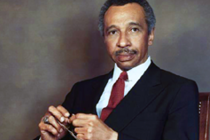Parren Mitchell Art-Sociology Building Dedication Ceremony

Parren Mitchell Art-Sociology Building Dedication Ceremony
Congressman Parren J. Mitchell was the first African-American student to take graduate classes at the College Park campus, and went on to become a noted civil rights leader, Maryland’s first black member of Congress and a founder of the Congressional Black Caucus. His fearless advocacy for his own continued education and for the education of all people was instrumental in the integration of the University of Maryland in 1950.
In his youth, Parren joined his brother Clarence Mitchell Jr.— who went on to become Chief Lobbyist of the NAACP—in protesting against segregation in the city of Baltimore. In 1942, Parren Mitchell served in the Ninety-Second Infantry Division of the US Army as a commissioned officer and company commander during World War II and received a Purple Heart. After his discharge in 1946, he attended Morgan State University under the GI Bill, and he received a Bachelor’s Degree in 1950. As he looked to continue his education at the master’s level, he was recruited to be part of a series of test cases brought by NAACP lead counsel Thurgood Marshall and University of Maryland School of Law alumnus Donald Murray, which was ultimately successful.
In October 1950, the Baltimore City Court ordered UMD to accept Mitchell as a full-time student in College Park, where he faced an unwelcoming environment. Despite these challenges, he graduated with a master’s degree in Sociology in 1952, with honors. Mitchell would state later that the sociological training he received at College Park would shape his activism in politics and social change for years to come.
After serving in many academic and public positions in the 1950s and 1960s, Mitchell became the first African American elected to Congress from Maryland in 1970, as well as the first African-American congressman from below the Mason-Dixon Line since 1898. Representing Maryland’s Seventh Congressional District, Congressman Mitchell was one of the 13 founding members of the Black Caucus, and became known as a staunch supporter of minority-owned businesses.
The naming of this Parren J. Mitchell Art-Sociology Building after the late congressman helps the University recognize and honor a great leader’s legacy by continuing to advance greater social inclusion, both on our campus and throughout the community at large.

